fuel type TOYOTA TACOMA 2012 Owners Manual (in English)
[x] Cancel search | Manufacturer: TOYOTA, Model Year: 2012, Model line: TACOMA, Model: TOYOTA TACOMA 2012Pages: 628, PDF Size: 12.11 MB
Page 2 of 628
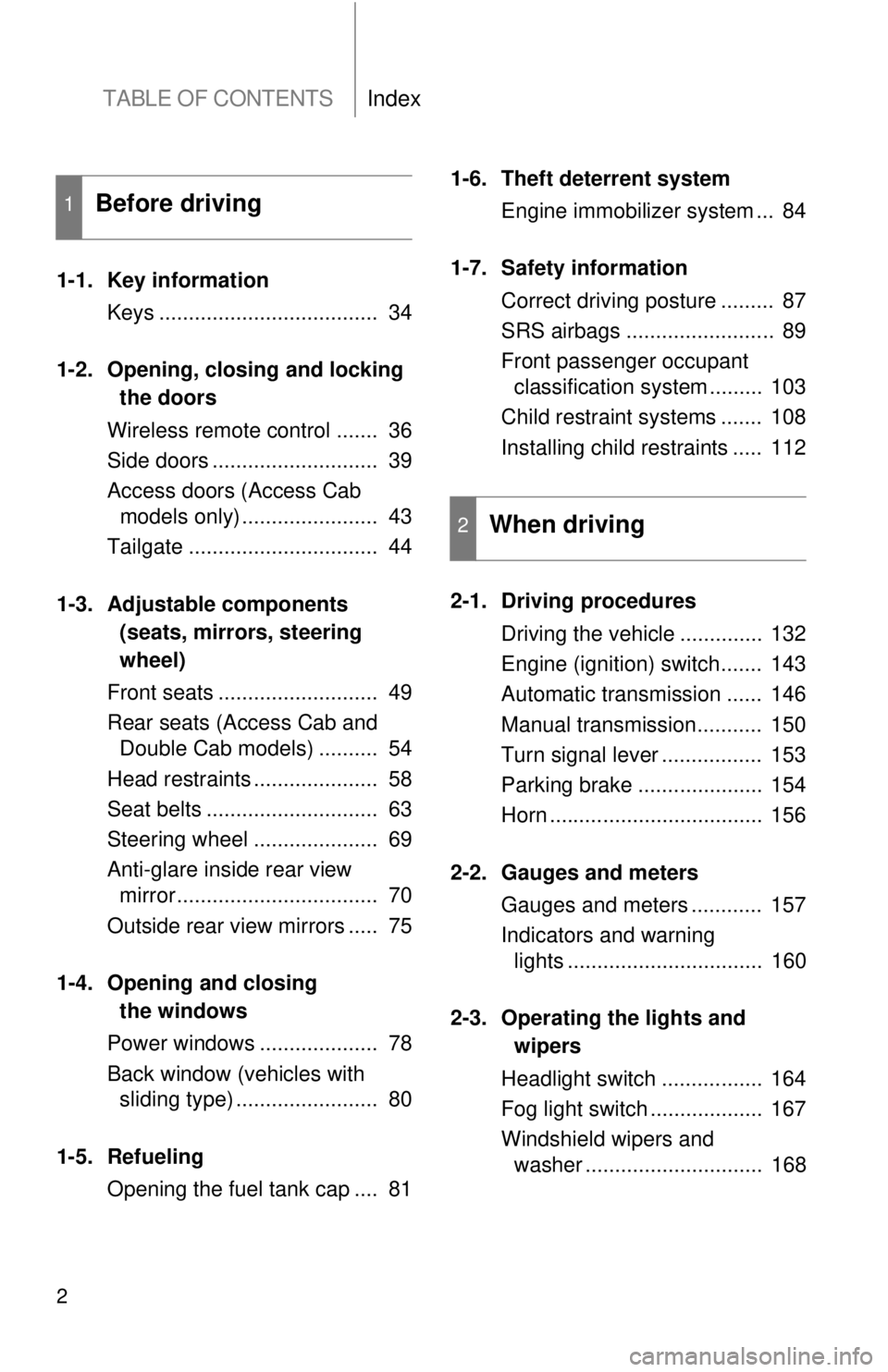
TABLE OF CONTENTSIndex
2
1-1. Key informationKeys ..................................... 34
1-2. Opening, closing and locking
the doors
Wireless remote control ....... 36
Side doors ............................ 39
Access doors (Access Cab models only) ....................... 43
Tailgate ................................ 44
1-3. Adjustable components
(seats, mirrors, steering
wheel)
Front seats ........................... 49
Rear seats (Access Cab and Double Cab models) .......... 54
Head restraints ..................... 58
Seat belts ............................. 63
Steering wheel ..................... 69
Anti-glare inside rear view mirror .................................. 70
Outside rear view mirrors ..... 75
1-4. Opening and clos ing
the windows
Pow er windows .................... 78
Back window (vehicles with sliding type) ........................ 80
1-5. Refueling Opening the fuel tank cap .... 81 1-6. Theft deterrent system
Engine immobilizer system ... 84
1-7. Safety information Correct driving posture ......... 87
SRS airbags ......................... 89
Front passenger occupant classification system ......... 103
Child restraint systems ....... 108
Installing child restraints ..... 112
2-1. Driving procedures Driving the vehicle .............. 132
Engine (ignition) switch....... 143
Automatic transmission ...... 146
Manual transmission........... 150
Turn signal lever ................. 153
Parking brake ..................... 154
Horn .................................... 156
2-2. Gauges and meters Gauges and meters ............ 157
Indicators and warning lights ................................. 160
2-3. Operating the li ghts and
wipers
Headlight switch ................. 164
Fog light switch ................... 167
Windshield wipers and washer .............................. 168
1Before driving
2When driving
Page 33 of 628
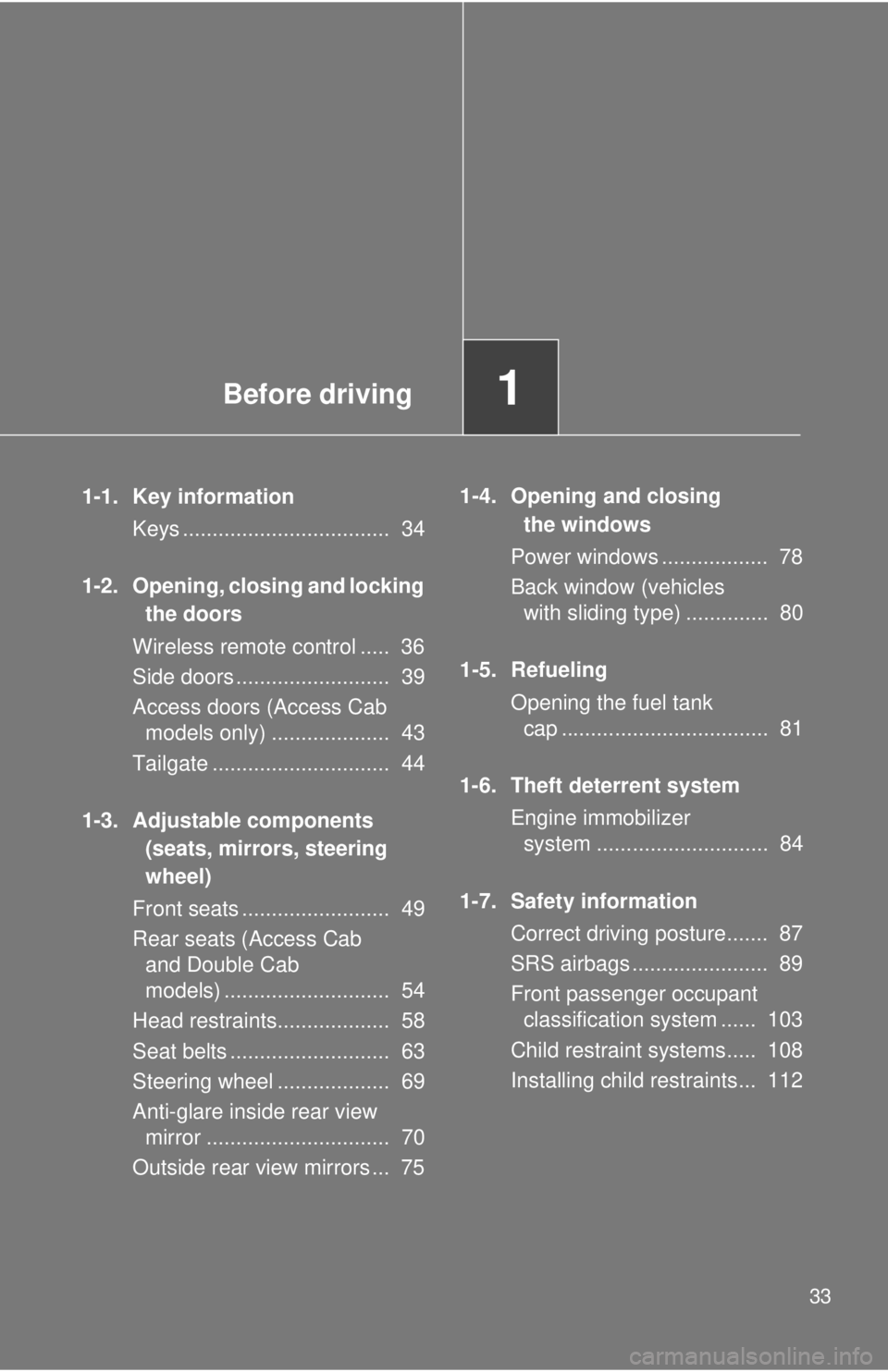
Before driving1
33
1-1. Key informationKeys ................................... 34
1-2. Opening, closing and locking the doors
Wireless remote control ..... 36
Side doors .......................... 39
Access doors (Access Cab models only) .................... 43
Tailgate .............................. 44
1-3. Adjustable components (seats, mirrors, steering
wheel)
Front seats ......................... 49
Rear seats (Access Cab and Double Cab
models) ............................ 54
Head restraints................... 58
Seat belts ........................... 63
Steering wheel ................... 69
Anti-glare inside rear view mirror ............................... 70
Outside rear view mirrors ... 75 1-4. Opening and closing
the windows
Power windows .................. 78
Back window (vehicles with sliding type) .............. 80
1-5. Refueling Opening the fuel tank cap ................................... 81
1-6. Theft deterrent system Engine immobilizer system ............................. 84
1-7. Safety information Correct driving posture....... 87
SRS airbags ....................... 89
Front passenger occupant classification system ...... 103
Child restraint systems..... 108
Installing child restraints... 112
Page 82 of 628
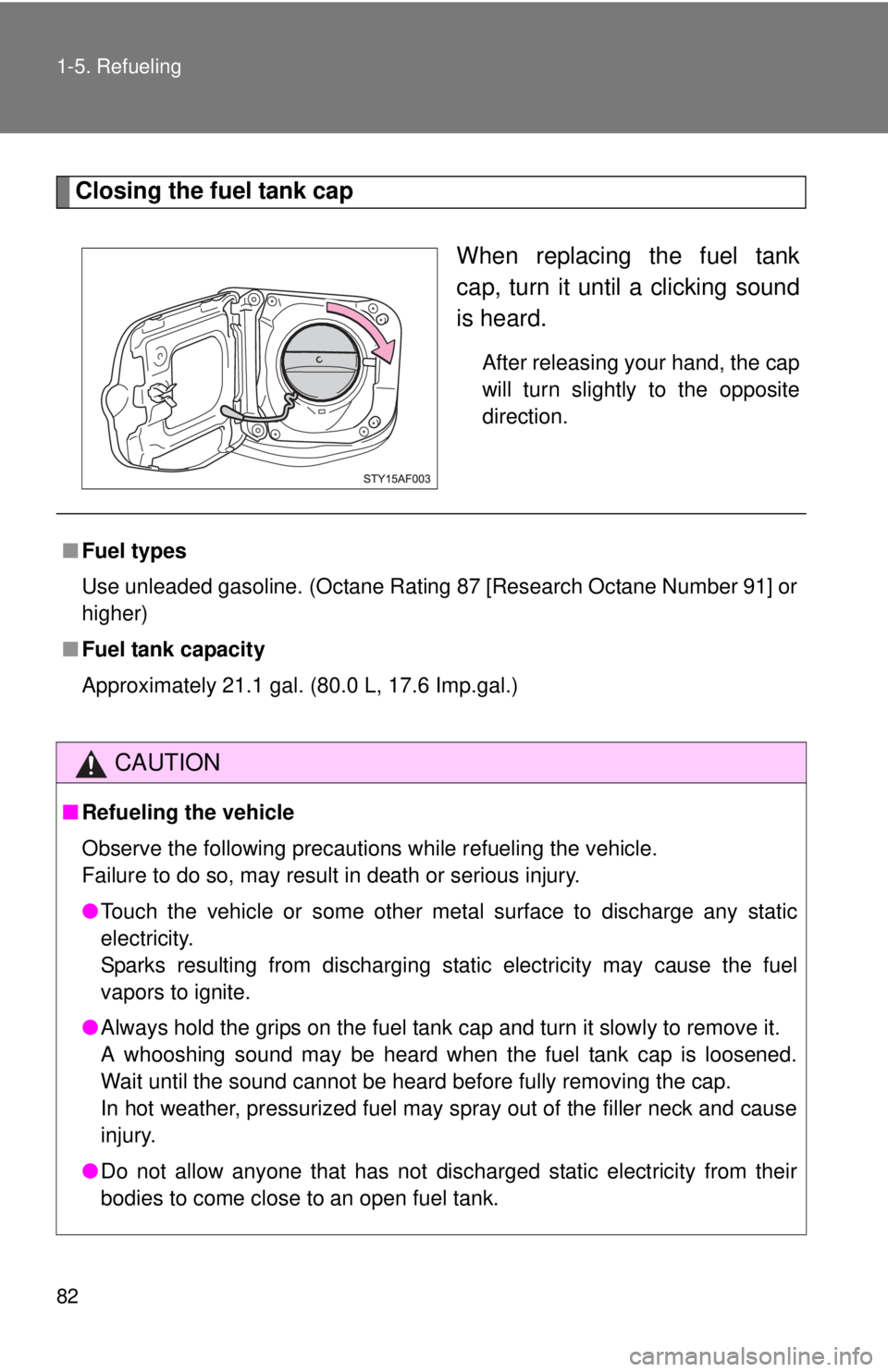
82 1-5. Refueling
Closing the fuel tank capWhen replacing the fuel tank
cap, turn it until a clicking sound
is heard.
After releasing your hand, the cap
will turn slightly to the opposite
direction.
â Fuel types
Use unleaded gasoline. (Octane Rating 87 [Research Octane Number 91] or
higher)
â Fuel tank capacity
Approximately 21.1 gal. (80.0 L, 17.6 Imp.gal.)
CAUTION
â Refueling the vehicle
Observe the following precautions while refueling the vehicle.
Failure to do so, may result in death or serious injury.
âTouch the vehicle or some other metal surface to discharge any static
electricity.
Sparks resulting from discharging static electricity may cause the fuel
vapors to ignite.
â Always hold the grips on the fuel tank cap and turn it slowly to remove it.
A whooshing sound may be heard when the fuel tank cap is loosened.
Wait until the sound cannot be heard before fully removing the cap.
In hot weather, pressurized fuel may spray out of the filler neck and cause
injury.
â Do not allow anyone that has not discharged static electricity from their
bodies to come close to an open fuel tank.
Page 548 of 628
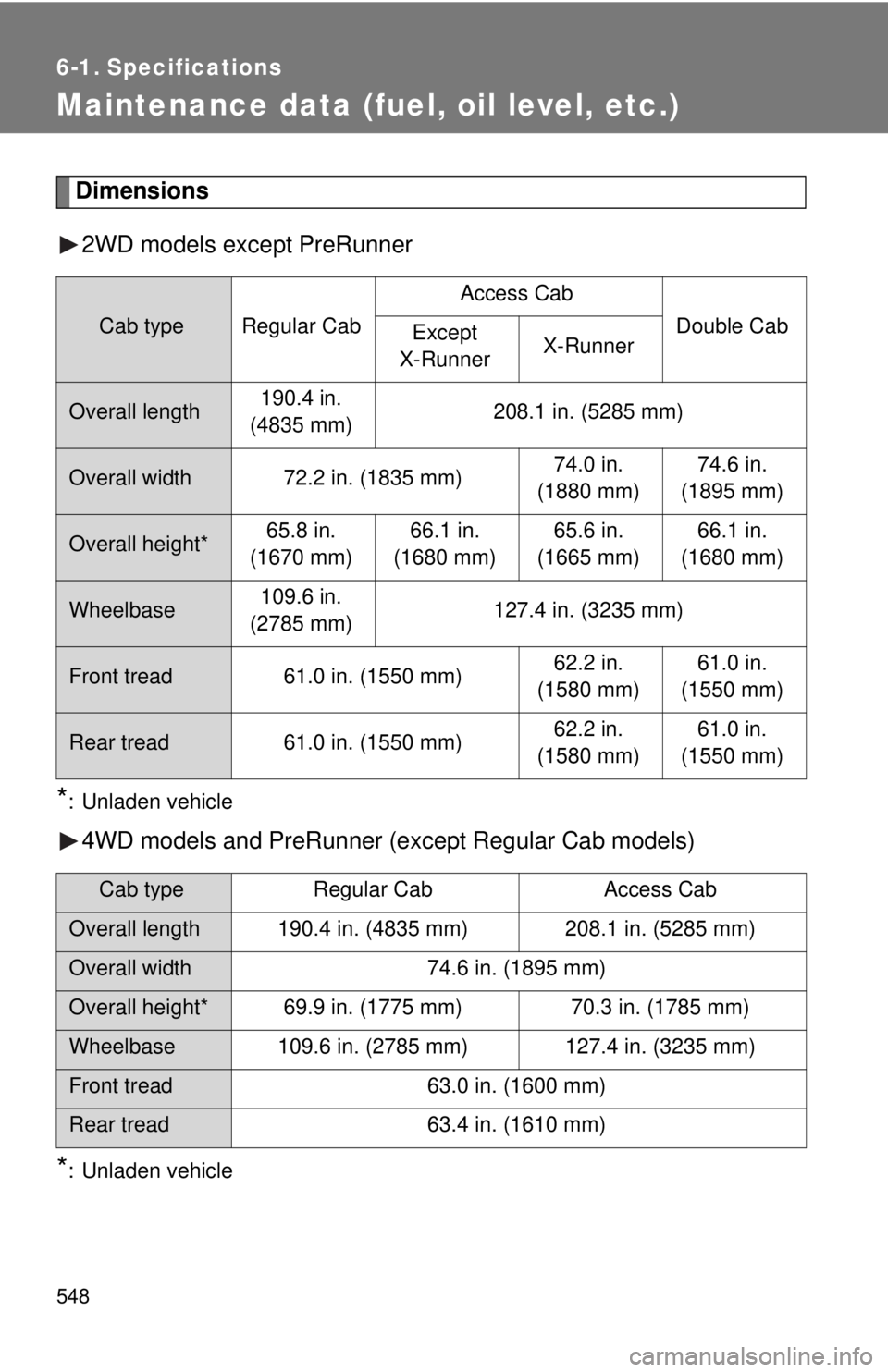
548
6-1. Specifications
Maintenance data (fuel, oil level, etc.)
Dimensions2WD models except PreRunner
*: Unladen vehicle
4WD models and PreRunner (except Regular Cab models)
*: Unladen vehicle
Cab typeRegular Cab
Access Cab
Double CabExcept
X-RunnerX-Runner
Overall length 190.4 in.
(4835 mm) 208.1 in. (5285 mm)
Overall width 72.2 in. (1835 mm) 74.0 in.
(1880 mm) 74.6 in.
(1895 mm)
Overall height* 65.8 in.
(1670 mm) 66.1 in.
(1680 mm) 65.6 in.
(1665 mm) 66.1 in.
(1680 mm)
Wheelbase 109.6 in.
(2785 mm) 127.4 in. (3235 mm)
Front tread
61.0 in. (1550 mm) 62.2 in.
(1580 mm) 61.0 in.
(1550 mm)
Rear tread 61.0 in. (1550 mm) 62.2 in.
(1580 mm) 61.0 in.
(1550 mm)
Cab typeRegular CabAccess Cab
Overall length 190.4 in. (4835 mm) 208.1 in. (5285 mm)
Overall width 74.6 in. (1895 mm)
Overall height* 69.9 in. (1775 mm) 70.3 in. (1785 mm)
Wheelbase 109.6 in. (2785 mm) 127.4 in. (3235 mm)
Front tread63.0 in. (1600 mm)
Rear tread63.4 in. (1610 mm)
Page 555 of 628
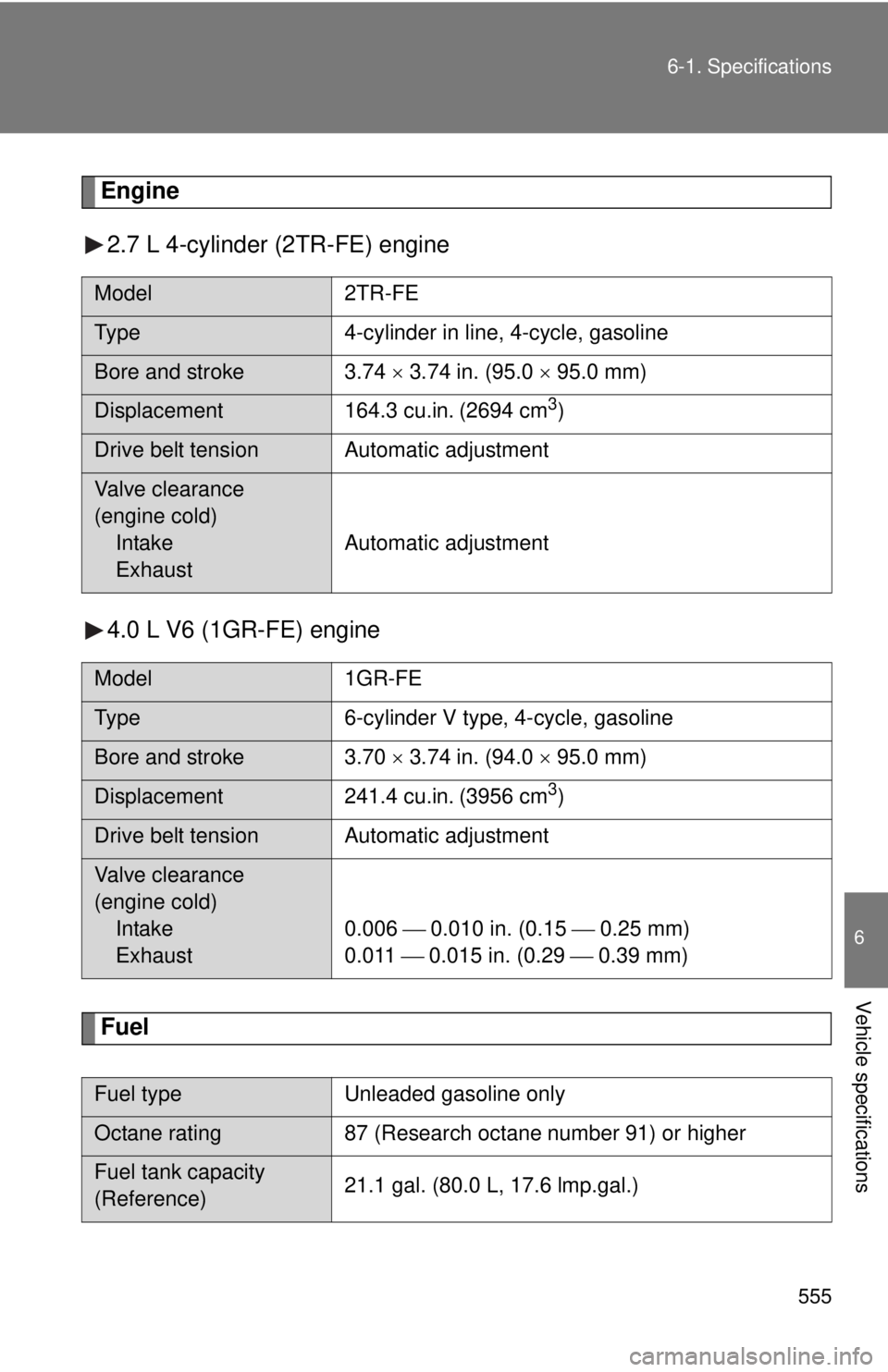
555
6-1. Specifications
6
Vehicle specifications
Engine
2.7 L 4-cylinder (2TR-FE) engine
4.0 L V6 (1GR-FE) engine
Fuel
Model 2TR-FE
Type 4-cylinder in line, 4-cycle, gasoline
Bore and stroke 3.74 ï´ 3.74 in. (95.0 ï´ 95.0 mm)
Displacement 164.3 cu.in. (2694 cm3)
Drive belt tension Automatic adjustment
Valve clearance
(engine cold)
âIntake
âExhaust Automatic adjustment
Model
1GR-FE
Type 6-cylinder V type, 4-cycle, gasoline
Bore and stroke 3.70 ï´ 3.74 in. (94.0 ï´ 95.0 mm)
Displacement 241.4 cu.in. (3956 cm3)
Drive belt tension Automatic adjustment
Valve clearance
(engine cold)
âIntake
âExhaust 0.006 ï¾ 0.010 in. (0.15 ï¾ 0.25 mm)
0.011 ï¾ 0.015 in. (0.29
ï¾ 0.39 mm)
Fuel type Unleaded gasoline only
Octane rating87 (Research octane number 91) or higher
Fuel tank capacity
(Reference) 21.1 gal. (80.0 L, 17.6 lmp.gal.)
Page 570 of 628
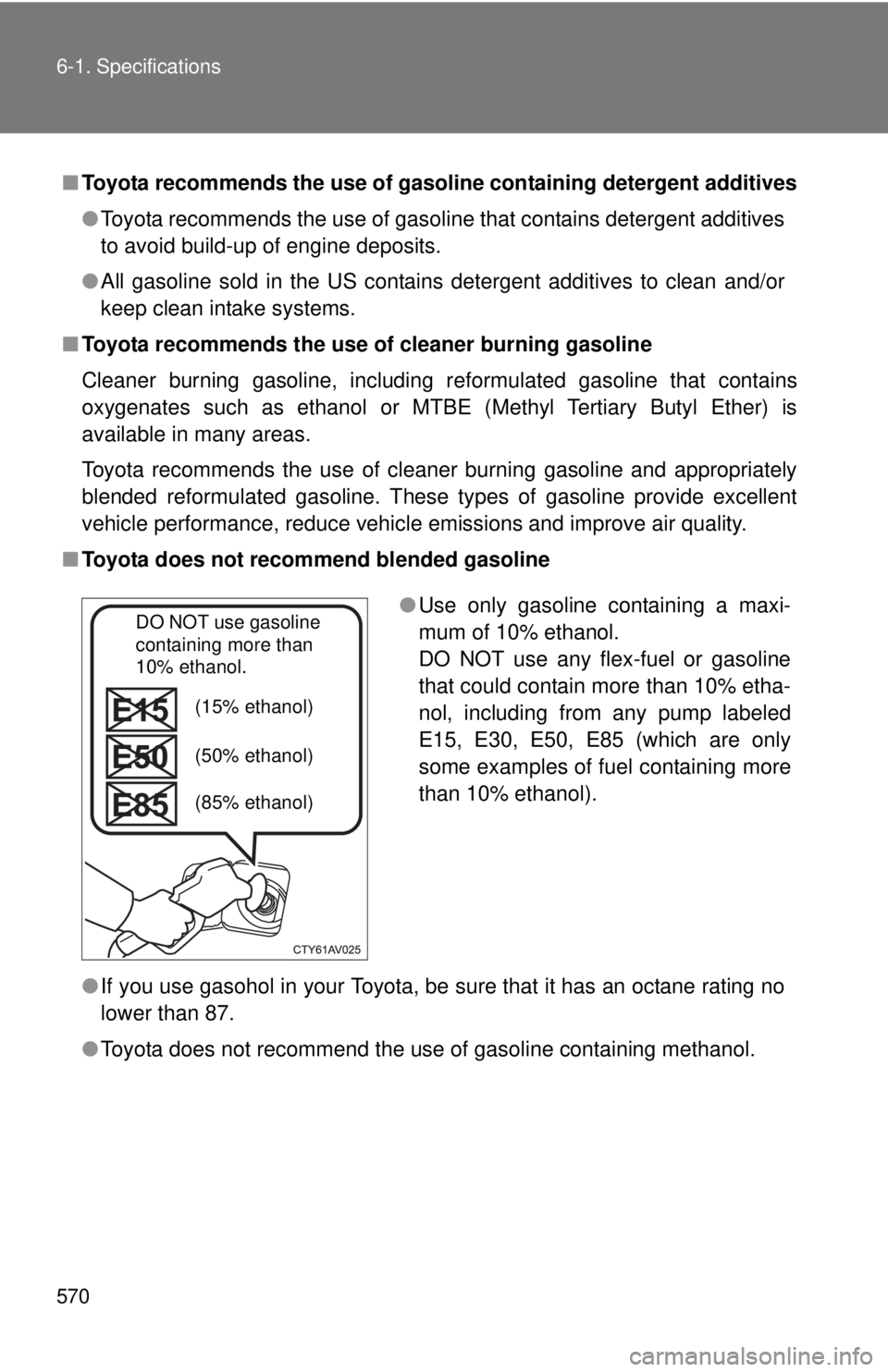
570 6-1. Specifications
â Toyota recommends the use of gaso line containing detergent additives
â Toyota recommends the use of gasoline that contains detergent additives
to avoid build-up of engine deposits.
â All gasoline sold in the US contains detergent additives to clean and/or
keep clean intake systems.
â Toyota recommends the use of cleaner burning gasoline
Cleaner burning gasoline, including reformulated gasoline that contains
oxygenates such as ethanol or MTBE (Methyl Tertiary Butyl Ether) is
available in many areas.
Toyota recommends the use of cleaner burning gasoline and appropriately
blended reformulated gasoline. These types of gasoline provide excellent
vehicle performance, reduce vehicle emissions and improve air quality.
â Toyota does not recomm end blended gasoline
â If you use gasohol in your Toyota, be sure that it has an octane rating no
lower than 87.
â Toyota does not recommend the use of gasoline containing methanol.
âUse only gasoline containing a maxi-
mum of 10% ethanol.
DO NOT use any flex-fuel or gasoline
that could contain more than 10% etha-
nol, including from any pump labeled
E15, E30, E50, E85 (which are only
some examples of fuel containing more
than 10% ethanol).DO NOT use gasoline
containing more than
10% ethanol.
(15% ethanol)
(50% ethanol)
(85% ethanol)
Page 571 of 628
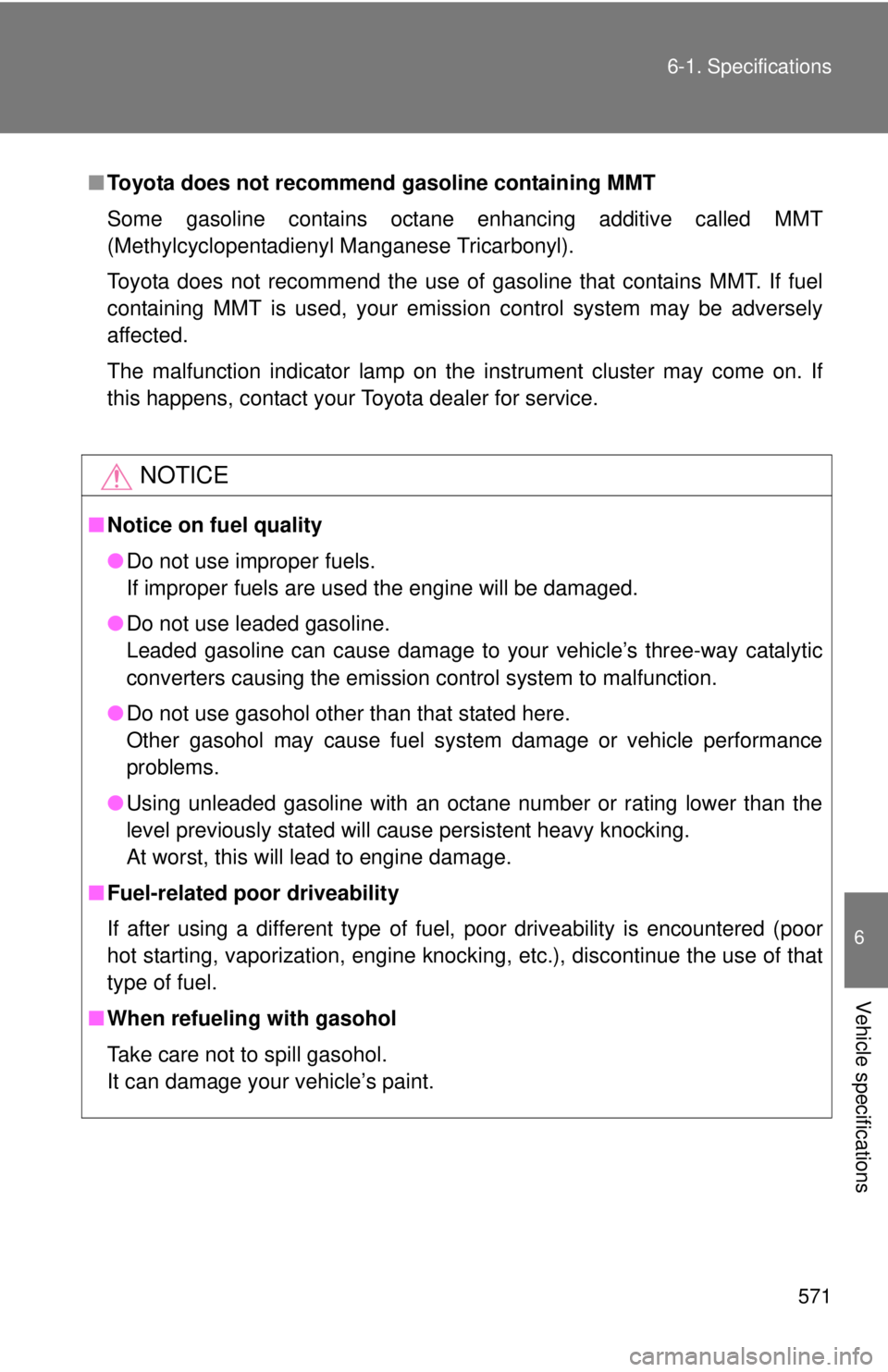
571
6-1. Specifications
6
Vehicle specifications
â
Toyota does not recommend gasoline containing MMT
Some gasoline contains octane enhancing additive called MMT
(Methylcyclopentadienyl Manganese Tricarbonyl).
Toyota does not recommend the use of gasoline that contains MMT. If fuel
containing MMT is used, your emission control system may be adversely
affected.
The malfunction indicator lamp on the instrument cluster may come on. If
this happens, contact your Toyota dealer for service.
NOTICE
â Notice on fuel quality
âDo not use improper fuels.
If improper fuels are used the engine will be damaged.
â Do not use leaded gasoline.
Leaded gasoline can cause damage to your vehicleâs three-way catalytic
converters causing the emission control system to malfunction.
â Do not use gasohol other than that stated here.
Other gasohol may cause fuel system damage or vehicle performance
problems.
â Using unleaded gasoline with an octane number or rating lower than the
level previously stated will cause persistent heavy knocking.
At worst, this will lead to engine damage.
â Fuel-related poor driveability
If after using a different type of fuel, poor driveability is encountered (poor
hot starting, vaporization, engine knocking, etc.), discontinue the use of that
type of fuel.
â When refueling with gasohol
Take care not to spill gasohol.
It can damage your vehicleâs paint.
Page 617 of 628
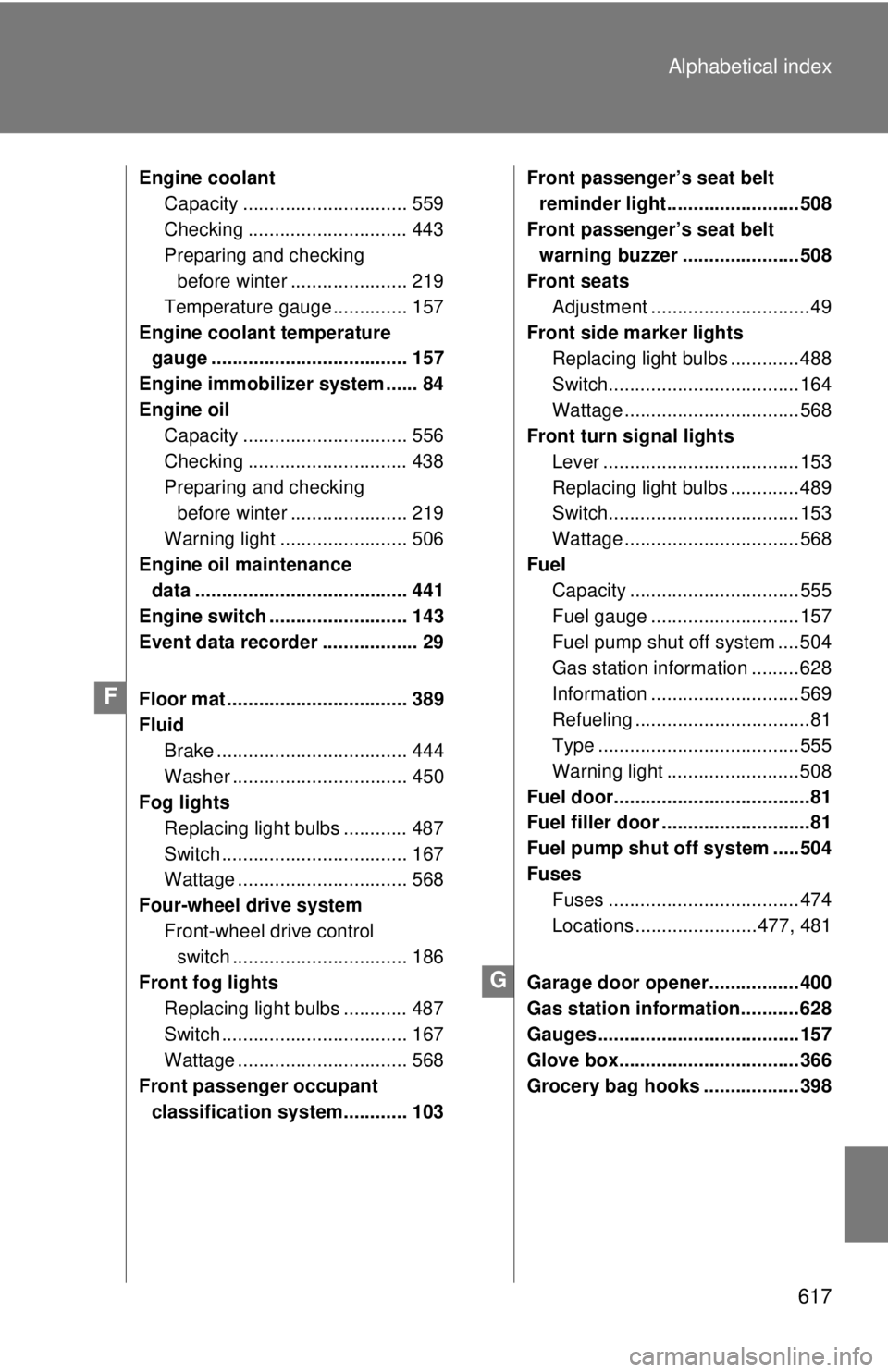
617
Alphabetical index
Engine coolant
Capacity ............................... 559
Checking .............................. 443
Preparing and checking before winter ...................... 219
Temperature gauge .............. 157
Engine coolan t temperature
gauge ..................................... 157
Engine immobilizer system ...... 84
Engine oil Capacity ............................... 556
Checking .............................. 438
Preparing and checking before winter ...................... 219
Warning light ........................ 506
Engine oil maintenance data ........................................ 441
Engine switch .......................... 143
Event data recorder .................. 29
Floor mat .................................. 389
Fluid Brake .................................... 444
Washer ................................. 450
Fog lights
Replacing light bulbs ............ 487
Switch ................................... 167
Wattage ................................ 568
Four-wheel drive system Front-wheel drive control switch ................................. 186
Front fog lights Replacing light bulbs ............ 487
Switch ................................... 167
Wattage ................................ 568
Front passenger occupant classification system............ 103 Front passengerâs seat belt
reminder light.........................508
Front passengerâs seat belt warning buzzer ......................508
Front seats
Adjustment ..............................49
Front side marker lights Replacing light bulbs .............488
Switch....................................164
Wattage .................................568
Front turn signal lights
Lever .....................................153
Replacing light bulbs .............489
Switch....................................153
Wattage .................................568
Fuel Capacity ................................555
Fuel gauge ............................157
Fuel pump shut off system ....504
Gas station information .........628
Information ............................569
Refueling .................................81
Type ......................................555
Warning light .........................508
Fuel door.....................................81
Fuel filler door ............................81
Fuel pump shut off system .....504
Fuses Fuses ....................................474
Locations .......................477, 481
Garage door opener.................400
Gas station information...........628
Gauges ......................................157
Glove box..................................366
Grocery bag hooks ..................398
F
G
Page 628 of 628
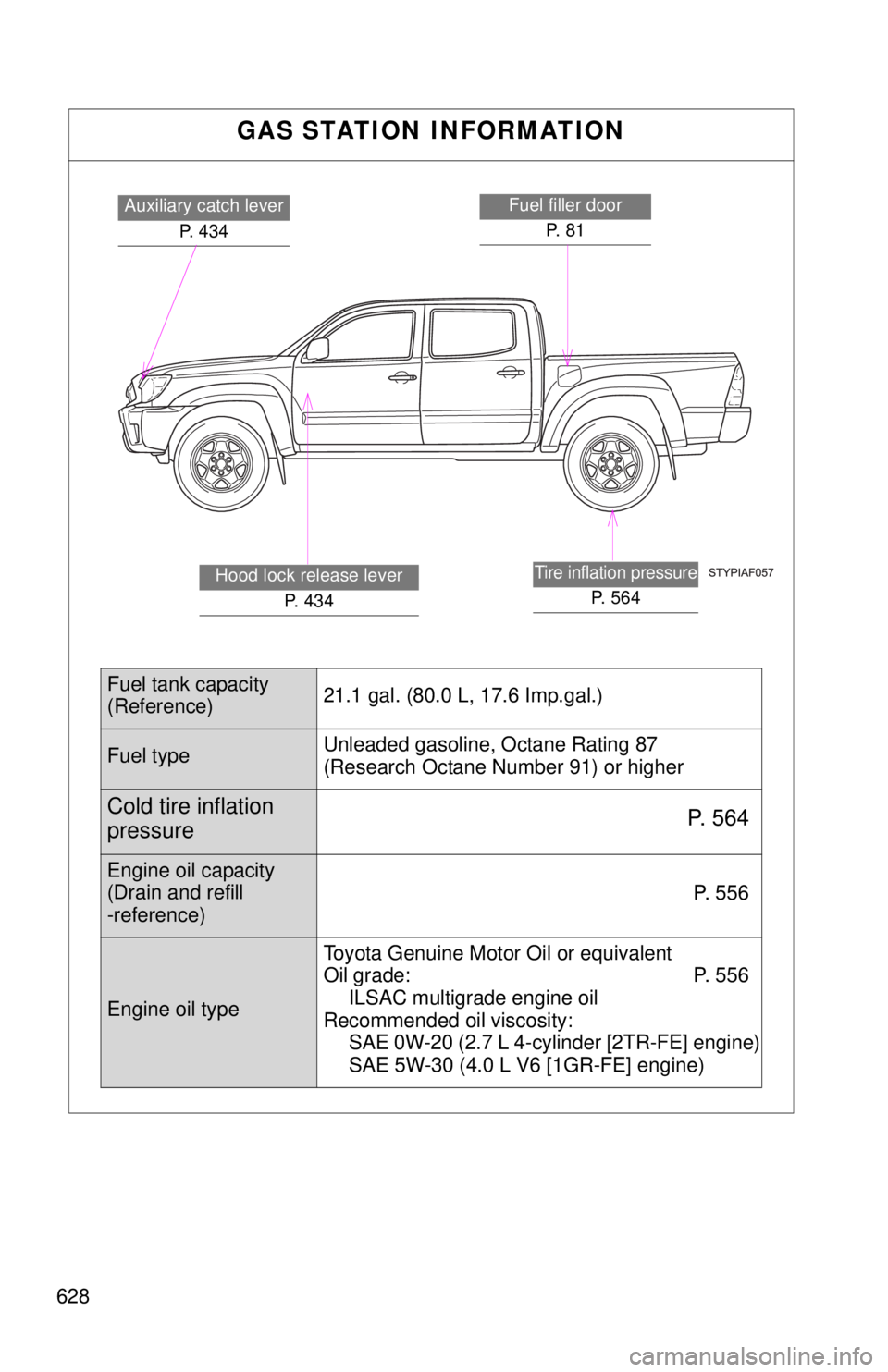
628
GAS STATION INFORMATION
Auxiliary catch leverP. 434Fuel filler doorP. 8 1
Tire inflation pressure
P. 564
Hood lock release lever P. 4 3 4
Fuel tank capacity
(Reference) 21.1 gal. (80.0 L, 17.6 Imp.gal.)
Fuel typeUnleaded gasoline, Octane Rating 87
(Research Octane Number 91) or higher
Cold tire inflation
pressure
P. 5 6 4
Engine oil capacity
(Drain and refill
-reference) P. 5 5 6
Engine oil typeToyota Genuine Motor Oil or equivalent
Oil grade:
P. 556
ILSAC multigrade engine oil
Recommended oil viscosity: SAE 0W-20 (2.7 L 4-cylinder [2TR-FE] engine)
SAE 5W-30 (4.0 L V6 [1GR-FE] engine)